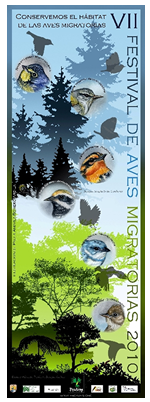 |
|
Paula Romero and Fernando Laverde. Fundación Arte y Conservación. |
October has come and we welcome 183 species of migratory birds that arrive in our country to celebrate the VII Migratory Bird Festival which, this year, will be held in 7 municipalities of Colombia.
Until 29th October different games and educational activities will be held in San Vicente de Chucuri, Zapatoca and Betulia, Santander; in Jardín, Antioquia; in Roncesvalles, Tolima department; in Genova, Quindio; Puerto Pinzón, village of Puerto Boyacá and Bogotá.
This Festival celebrates the incredible journey back and forth these birds make each year flying thousands of miles over glaciers, forests, mountains, beaches, islands and oceans. During their journey they face extreme weather conditions including storms, high winds and extreme temperature changes. In the same way they must overcome their own physical limits to combat fatigue caused by the strenuous exercise that comes from such an enormous displacement.
On reaching our countries these birds seek favorable habitats to spend two thirds of the year but unfortunately on each trip they find a landscape more more transformed which increasingly threatens their survival.
Aware of this threat ProAves has been developing since 2004 the Migratory Bird Festival and this year, our seventh version, we want to emphasize the importance of the conservation of migratory bird habitat and create awareness and community engagement to preserve and ensure their return on every migration trip.
The migration occurs thanks to physiological adaptations that allow birds to fly long distances to exploit food resources depending on the season and increase their reproductive success. Variations in patterns of migration are as many as the numerous types of birds that migrate. Tanagers, warblers, raptors, vultures, finches, herons, ducks, among others.
Of the 183 species of migratory birds that are registered in Colombia, neotropical migrants, i.e. those species that breed in Canada and the United States from April to June, are the most abundant. These birds spend two thirds of the year in the tropics and can be seen from July to March, with October, the highest peak of abundance.
Colombia’s strategic position in northern South America is the gateway for millions of these individuals, year after year, some stay in our country and others continue their way further south. Most birds that migrate over long distances travel at night when temperatures are cooler, the air is calm and their predators, birds of prey, are not active.
[slickr-flickr search=”sets” set=”72157625169690272″ items=”20″ type=”gallery”]
Environmental education activities performed in the Festival.
Although birds accumulate fat reserves of up to 50% of their body weight before leaving the rigors of long distance flights require that most of the birds stop, rest and refuel several times before reaching their final destination. Without suitable places along the route that provide a fast and adequate supply of fat reserves, shelter from predators and water for rehydration it is difficult for them to continue their journey.
As part of its activities, Fundación ProAves has developed the National Monitoring and Migratory Bird Conservation Program which has, as one of its purposes, to implement a monitoring network of migratory birds along the Colombian territory to assess their distribution, movements and the threats they face to ensure their survival through effective conservation action in key areas, raising awareness in communities, strengthening local capacity in monitoring techniques and creating strategic alliances for conservation.
The fact that biodiversity is at risk is a reflection of the health of the environment that supports it. Human beings need a healthy environment to survive, with availability of fresh water, fertile soils and clean air. To that extent conserving migratory birds is conserving ourselves, it is to begin to rebuild a better environment, to ensure a better future for coming generations.
With support from the following organizations:
 |
